How construction can make the switch to low-carbon concrete
28 February 2023
The headline statistic on concrete is stark, to say the least. The world’s most heavily used construction material is responsible for around 8% of the world’s carbon emissions.
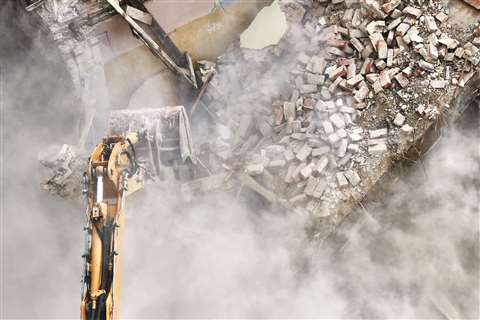 While a host of alternatives to concrete exist, the cost of scaling them up is currently high. Photo: Adobe Stock
While a host of alternatives to concrete exist, the cost of scaling them up is currently high. Photo: Adobe Stock
With this in mind, it is concerning that there is still no globally agreed standard for what constitutes low-carbon concrete.
What is agreed is that, for every tonne of standard cement produced, a tonne of CO2 is released. And cement alone is responsible for between 5% and 7% of total global carbon emissions.
Notwithstanding these emissions, that have traditionally been a by-product of concrete’s manufacturing process, there is no denying its literally monumental benefits.
Currently, there is no affordable, flexible and long-lasting material on the planet that can be used in construction to the extent concrete is used.
Unfortunately, the climate crisis demands more than utility; it demands sustainability. Here again, admirers of concrete have an argument: its thermal mass allows it to effectively absorb temperature variations, reducing energy consumption within buildings.
It also has a role to play in the circular economy, and we have seen an increasing number of projects demonstrating impressive materials recycling initiatives, as well as a growing use of industry by-products in concrete’s manufacture.
Circular economy
The Concrete Initiative is a European project led by a number of cement, concrete and aggregates associations. One of its roles is to highlight the benefits of concrete, from a societal, economic and sustainable perspective.
The organisation cites a number of exemplar case studies, including Switzerland’s Gotthard Base Tunnel, the world’s longest railway tunnel at a little more than 57km.
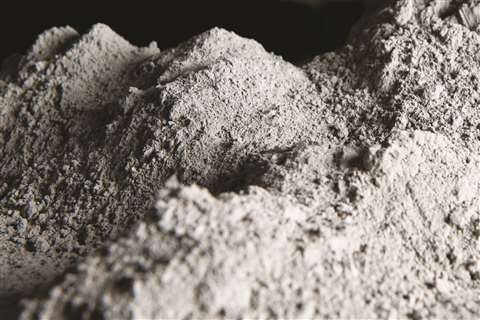 Cement is the real elephant in the room, responsible for up to 7% of global carbon emissions Photo: Heidelberg Materials
Cement is the real elephant in the room, responsible for up to 7% of global carbon emissions Photo: Heidelberg Materials
The tunnel itself has undeniable sustainability credentials, such as switching a huge amount of road traffic – both passenger and freight – to rail.
In constructing the tunnel, a total of more than 28 million tonnes of material had to be excavated. This resulted in another sustainability tick as all of the aggregates required for the tunnel’s concrete construction came directly from this excavated material.
Without question, we are seeing a shift, both from manufacturers and end users of concrete, towards more sustainable practices.
Talking points
The question of what can be done right now to reduce Concrete’s impact on emissions was recently put to experts at the World Economic Forum in Davos, during an event hosted by the global management consulting firm McKinsey & Company.
A number of levers to decarbonise concrete along its value chain were discussed:
Reducing the amount of clinker in cement – clinker accounts for approximately 90% of the emissions released in cement production; the effect can be reduced by substituting, for example, fly ash, metal slag or calcined clay.
Reducing the CO2from energy used in the production process – manufacturers are investigating alternative fuels and newer technologies such as kiln electrification, as well as developing proprietary waste-recycling businesses that target the use of industrial and municipal waste in their kilns.
Storing or utilising remaining CO2emissions – at the Davos event, cement and concrete producers described how CO2 can be stored in concrete aggregates when construction and demolition waste is recycled.
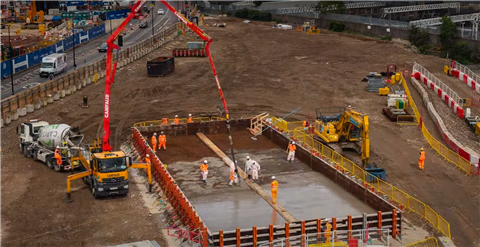 Contractor John F Hunt pouring EFC at London’s Euston Station as part of UK’s HS2 project Image: John F Hunt
Contractor John F Hunt pouring EFC at London’s Euston Station as part of UK’s HS2 project Image: John F Hunt
According to McKinsey, the industry is open to the development of a more circular attitude to cement and concrete.
There is, the organisation said, an enthusiasm for ‘greening’ the process, bus also uncertainty regarding how best to invest in these value chains.
Catalysts of change
Yet, as the great diesel engine is now beginning to be challenged by more sustainable propulsion methods, such as battery-electric and hydrogen power, so the building material that has been with us since the neolithic age may finally have some sustainable competition.
Swiss-based materials manufacturer Holcim currently offers ECOPact, a broad range of low-carbon concretes, which promises to produce up to 90% less CO2.
The company is somewhat vague about the techniques and technologies it employs to achieve these numbers, and it has been reported that a significant amount comes from offsetting carbon, potentially through tree planting or forest conservation.
Scaling up
One of the problems with ‘greener’ concrete is scaling it up, although things are beginning to improve.
In the UK, the High-Speed 2 (HS2) rail project is currently one of the world’s largest infrastructure undertakings.
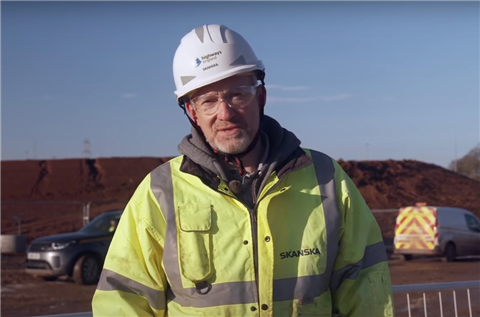 Paul Cole, a chief engineer with Skanska UK Image: Skanska
Paul Cole, a chief engineer with Skanska UK Image: Skanska
At London’s Euston Station, the construction team of contractor John F Hunt has been utilising Earth Friendly Concrete (EFC), developed by the Australia-based materials provider Wagners.
At the heart of EFC is a geopolymer system that binds industrial waste to make zero-cement concrete. According to Wagners, 400kg of waste material is reused in every m3 of concrete, resulting in a 75% reduction in carbon emissions, compared with traditional concrete.
Daniel Sweeny, group sustainability manager for John F Hunt, said, “We have made significant progress in lowering our operational carbon within the Group; however, our greatest challenge now is working with our supply chain to reduce our embodied carbon.
“Collaborating with Capital Concrete to pour Earth Friendly Concrete at our HS2 Euston project allowed us to save over 30 tonnes CO2e as a direct result. The consequence of this saving is being applied throughout John F Hunt, and we will increase our use of EFC, viewing it as a necessary product to help the construction industry achieve net zero.”
This is a good news story. The not-so-good news is that HS2 could potentially have reduced its carbon footprint by 2.5 million tonnes, had EFC been used across the entire project – that’ the same weight as 38 aircraft carriers.
Scaling up, though, will take time, and it’s time we may not have.
‘Wonder product’
In another UK-based example, as part of a motorway improvement scheme, Skanska recently undertook a trial, using a low-carbon reinforced concrete.
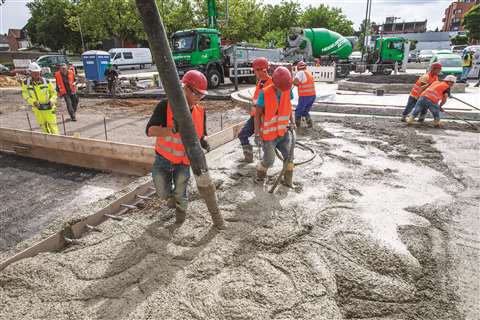 Workers pour Heidelberg Materials’ TioCem, which has properties able to reduce air pollution Photo: Heidelberg Cement
Workers pour Heidelberg Materials’ TioCem, which has properties able to reduce air pollution Photo: Heidelberg Cement
Paul Cole, a chief engineer on the project, said, “We’re doing this innovation project to see if we can remove carbon from concrete and remove steel from our reinforced concrete structures.”
Cole says, “We’re using an alkali activated cementitious material, along with a fibre reinforced polymer,” which, put simply, means the concrete contains no high-carbon cement, nor steel rebar. The cement replacement – which Cole calls “a wonder product” – kick-starts the reaction required to make the concrete harden, but has a much lower carbon footprint than cement.
Cole is pragmatic about how challenging it is to make the seismic shift away from standard concrete. He says, “The solutions are not there for us to simply pick up and run with. We have to investigate them, we have to trial them, we have to test them, research them.”
Perhaps, most importantly, he says, “We have to convince our clients that what we’re proposing works and that it will be the appropriate material to use in their permanent works.”
Carbon capture
Talking of convincing customers that you mean business, the German materials company that used to trade as Heidelberg Cement recently changed its name to Heidelberg Materials – that’s how serious the firm is about its own sustainability credentials.
Dr Dominik von Achten, chairman of the company’s managing board, said, “Our future is sustainable.
“We will be the first company in the world to offer carbon-free cement at large scale as early as 2024. We are vigorously driving forward the scaling of our CCUS [carbon capture usage and storage] activities: by 2030, we will reduce our CO2 emissions by 10 million tonnes with the projects we have already launched.”
 Thomas Guillot, CEO of the Global Cement and Concrete Association Photo: GCCA
Thomas Guillot, CEO of the Global Cement and Concrete Association Photo: GCCA
One of these projects is the construction of a full-scale carbon capture installation at the firm’s Brevik cement plant in Norway.
A world first, the Norwegian facility is expected to capture approximately 50% of the carbon in its emissions by 2024, totalling around 400,000 tonnes annually.
In Slite, Sweden, Heidelberg’s subsidiary Cementa operates a plan four times the size of its Norwegian counterpart. This facility produces around 75% of the cement used for all concrete production in Sweden.
Here, Heidelberg is set to build a carbon capture facility, which is expected to be capturing 1.8 million tonnes of CO2 by 2030 – equivalent to the plant’s total emissions.
Additionally, Heidelberg’s subsidiary Cementa will introduce biomass to the fuel mix, furthering the emissions reduction.
A feasibility study for the project has concluded that the plant’s harbour location means transporting the carbon to a permanent offshore storage site and placed several kilometres down in bedrock is a workable solution.
The last word in sustainability
The members of the Global Cement and Concrete Association are in the main materials manufacturers, so one might assume there is some bias towards the continued use of these materials in construction.
Yet Thomas Guillot, the organisation’s chief executive, says, “We are asking for support from policymakers to create market demand for low carbon products in construction and public procurement. Policy reforms and the promotion of low carbon products can make a big difference as public infrastructure accounts for almost 60% of all global cement and concrete demand.
Guillot says “It is critical that the industry has government support to expand the successful pilots across the world towards commercial scale deployment.
“We also need the wider construction industry to work with us toward the ambition of net zero concrete. Construction professionals, working with us and policymakers, will be key to developing the design and regulatory framework that will drive efficient use of resources and products, use of reprocessed and recycled material and the re-use of elements, as well as other technology to reduce materials and extend the lifetime of whole projects.”
|
Renewable energy meets sustainable concrete 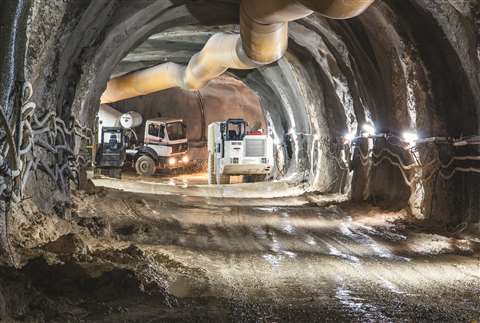
Mexico-headquartered materials giant Cemex is putting itself on the sustainability map in southeastern Europe, with its Vertua lower-carbon cement being used on three major renewable energy projects in Croatia and Bosnia and Herzegovina. Ivovik wind farm in Bosnia and Herzegovina will have 20 wind turbines and is expected to produce enough energy to meet the demand of more than 100,000 households. Cemex is supplying Vertua Ultra lower carbon cement for the turbine concrete foundations. Cemex’s Vertua Plus cement is also being used to produce concrete for the foundations of wind farm projects near Obrovac in the Dalmatia region of Croatia. And finally, Cemex has provided 21,000 tonnes of cement to produce concrete installed in the tunnel lining at the Dabar hydropower project in Eastern Herzegovina. Sergio Menéndez, President of Cemex Europe, Middle East, Africa & Asia, said, “We are proud to support the renewable energy transition with our Vertua family of products,” said. “Cemex is constantly innovating building solutions to enable its customers to be at the forefront of a lower carbon and circular construction industry.” Image: The Dabar hydropower project in Herzegovina. Photo courtesly: Cemex |
STAY CONNECTED



Receive the information you need when you need it through our world-leading magazines, newsletters and daily briefings.
CONNECT WITH THE TEAM








